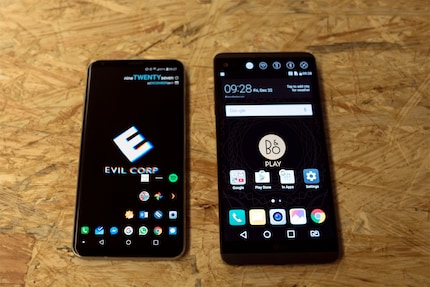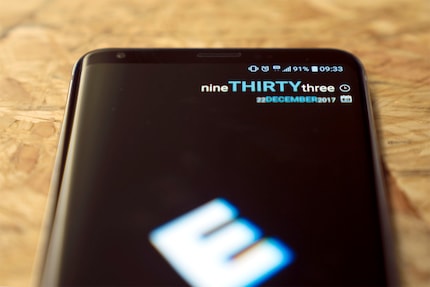
Product test
LG V20 – The beast from the east
by Dominik Bärlocher
The LG V20 was my phone of the year in 2016, but the LG V30 didn't even make it into the top seven of the year. Is the phone bad? Not at all. It's actually very good and easily keeps up with the flagships of the year. So why my seemingly scathing judgement, which does the phone a massive injustice?
I like LG. Especially the V series. The G series is presented by the manufacturer every year as the flagship series, with keynote speeches, PowerPoint presentations and applause from the audience. But phone connoisseurs know: The G-series has no bread against the V-series. The V-Phones are always launched in late summer or autumn, later than most flagships of the year, but they are projects that show courage.
The V20 was easily my phone of the year in 2016. The second screen was a feature that slowly crept into everyday life after the purpose of the then revolutionary new Always On Display was not entirely clear at first. But after just a few weeks with the phone, I couldn't do without the feature.
Why am I rambling on about a phone that's a year old when you're here to read about the new LG V30? I want you to understand how I approached the test. With a lot of expectations, well-deserved advance praise from my own experience and curiosity.
Well,
I have never waited as impatiently for a phone as I did for the V30. Help came from product management: I should keep an eye on the V30+, because as a Korean import we might get it faster. I'm not going to let myself get carried away. I want that thing. Very firmly.
The differences between the two phones can easily be counted on one hand. On the hand of a two-fingered sloth, even.
I finally have it in front of me, in midnight black or whatever fancy name LG have come up with for "black". Since I held the phone, which weighs almost exactly 160 grams with a SIM card, in my hand at IFA, I know what to expect.
There we have the salad. Sure, LG has installed top specs. Sure, LG has gone to great lengths. Sure, LG can easily keep up with the V30 and leaves the competition eating dust in many respects when it comes to user-friendliness for hobbyists and power users. But the phone is just a phone. Where is the courage from last year? Where is the will to do something different?

Unfortunately, the LG V30 no longer has an extra screen. Too bad
Throughout the entire test period, I can't shake the feeling that the phone is a device that could have been so much more if LG had shown a little more courage and inventiveness. If they had dared to do something different, to offer users something new, something exciting, then the phone would be so much more than the rectangle with rounded corners in front of me. As it is now, the LG V30 is one of many. Above all, it lacks the second screen at the top that made the LG V20 the star of the year. Not because I immediately fell in love with the small screen back then, but because it crept into my everyday life. Gradually, I found it more and more useful and in the end, I didn't want to be without it. LG has thought about the functionality and included a feature called "Floating Bar" in the software, but it is absolutely useless. LG itself doesn't seem to believe in the feature either, as it is deactivated by default. You get the same functionality as the floating bar if you pull down the status bar - the screen element where you can see the battery status. LG could have saved on engineering here.
Luckily, a test is so much more than just "I want fancy hardware gizmos". Because if that were the only argument, then I would be doing the LG V30 an injustice.
As soon as you start it up, it becomes clear that LG hasn't simply incorporated a new user interface for the operating system - currently still Android 7.1.x - into the phone. Because the device is fast. Extremely fast. I can't say exactly where LG has optimised what, but it simply flows faster.
This is not only due to the animation speed, which seems to be slightly faster. Complex processes such as starting up the camera or switching from the normal camera to the wide-angle camera are also faster. Sometimes the V30 gets a little hot when it really has to exert itself during 3D rendering or benchmarks, but the device never, ever thinks about giving up. Slowing down? Not a chance. Despite its light weight and all, the LG V30 is a small powerhouse that delivers.
About the camera: It still works absolutely great. The software is intuitive, fast and the quality of the images is in the top third. The LG V30 is also the first phone to support 10-bit colour depth. My colleague Manuel Wenk, one of our video producers, took a closer look at this function.
The battery pulls cleanly. I rarely get below the 40 per cent brand after a day of heavy use. That's what makes a phone fun. Not that I feel the need to push it at all times, but the V30 is a reliable partner. I just feel good with the V30 in my pocket because I know that the machine will keep up with the person.
"One of many"? Not at all. Well, I like LG's V series anyway, which is why this verdict should probably be taken with a certain amount of scepticism. I admit that.
It's a shame that the LG V30 is so arbitrary on the hardware side. And, above all, that the second screen has been abolished. Of course, the entire front screen is now equipped with OLED technology, which results in battery and image optimisation. Each pixel can be controlled and illuminated individually. Black pixels, which are HEX #000000, are not supplied with power at all.
On the V20, only the upper screen was equipped with OLED technology. AMOLED, or OLED, essentially amounts to the same thing in use and has become the standard for flagships in the past year. So a theoretical second screen would no longer be a technological novelty along the lines of "Wow, look, an AMOLED screen", but it would still be nice to use.

Still beautiful. The entire screen is equipped with OLED technology, which makes the colours look richer across the board
Because LG has become tame when building the phone from the series that portrays LG as an adventurous manufacturer. Where is the wildness? Where is the courage to do something different? Sure, LG has taken a beating in the mobile phone sector in recent years, but becoming like everyone else is not the right way to go. Because everyone else is already like that. This is the chance to just think "Alright... fuck it all" and get really wild. Snapdragon 835 as a solid platform, then experiment away.
In the end, I'm left with a phone that I like. The V30 is great to use. It's fast, it lasts, it's waterproof and everything. But it doesn't live up to the praise. Unfortunately.
LG, I sincerely wish you success, because a year ago, with the V20, you showed that you've got it bad. Don't become tame. Stay wild.
Journalist. Author. Hacker. A storyteller searching for boundaries, secrets and taboos – putting the world to paper. Not because I can but because I can’t not.